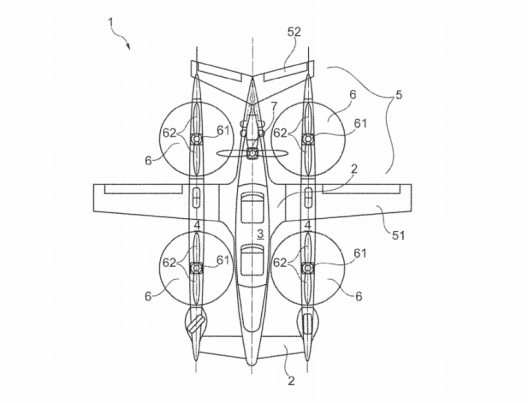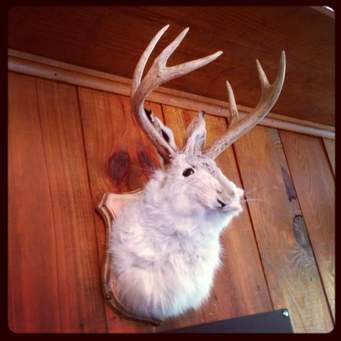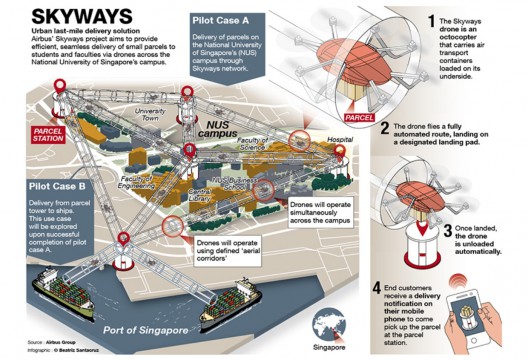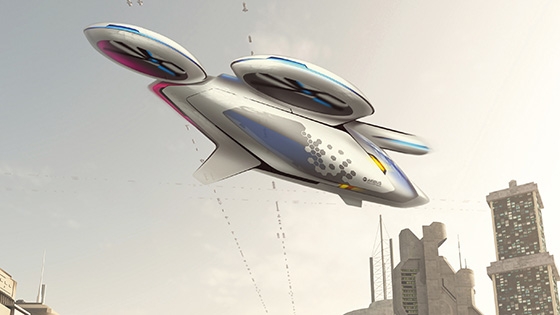Airbus and its partner Local Motors have just finished a successful design challenge for delivery drones that can carry things like emergency medical supplies to selected destinations. Recent announcements and the release of a patent drawing show Airbus is doing serious work toward delivering humans to their selected destinations in a scaled-up version of such drones. Many brilliant people have tried to combine the benefits of ground and air transport over the years, including Molt Taylor, designer of the rightly famous Aerocars. The example at Seattle’s Museum of Flight causes docents to lower their voices out of respect for the accomplishment.
That’s certainly a concept promoted for last decade by Dr. Brien Seeley, head of the Sustainable Aviation Foundation and sponsor for this blog. His AIAA paper on Regional Sky Taxis spells out his hopes for alleviating ground-bound gridlock with aerial alternatives.

The Airbus A3 patent drawing for a sky taxi VTOL machine
Recently, Airbus formed a group in California’s Silicon Valley called A3, or A Cubed. The group earned a patent on a large quadrotor, passenger-carrying machine which could well be an aerial Uber-type vehicle. That certainly fits its Airbus parentage. A3’s web site contains this mission statement:
Unicorns and Jackalopes
“We are the Silicon Valley outpost of Airbus Group, the parent of Airbus (the leading maker of large commercial aircraft), Airbus Helicopters (the world’s largest supplier of civil helicopters), and Airbus Defense & Space (which makes satellites, drones, and military aircraft, and provides cyber defense capabilities). The mission of Airbus Group is to make things that fly. Our aim is to define the future of flight.
“We believe that the future is created through episodic disruption with intervening periods of incremental innovation. Our mission is to build the future of flight now, by disrupting Airbus Group and its competitors before someone else does.
“We solve big problems by employing world-class experts and by developing fertile partnerships. Our projects are built on rigorous analysis, novel insights, and commitment to unreasonable goals. We fly in the face of risk and deliver with maximum speed. We are A³ by Airbus Group.”

Jackalope, a creature blending jackrabbit and antelope, often seen on tavern walls in the American West
Willing to take big risks to achieve unreasonable goals, it follows that a typical executive in the group would be a different breed, because he or she would lead a unicorn organization – a Silicon Valley startup worth over a billion dollars (at least at the parent company level). Airbus describes a project manager like Jane Jackalope, a mythical creature leading a rare company. “You are a jackalope of all trades. You are that rare creature at the intersection of a dreamer, a project manager, a chief engineer, and an evangelist. You are the world’s leading expert in your domain. You have an idea that will disrupt it. And you are passionate about bringing this idea to life.”
One would expect a big leap in technology from a company that sponsors the Perlan Project, with their patented design for their commuter – a multipropeller City Airbus vehicle – looking a great deal like the future in the film The Fifth Element (in which Bruce Willis played an aerial cab driver but the cab was more Checker-like). There won’t be a driver on these sky taxis, though, everything guided by programming similar to that being devised for a pilot test program in Singapore.

Airbus/National University of Singapore (NUS) plan for cargo delivery network on the island. Passenger model may follow similar routing system
A Competitive Link
With 425 entries from their recent Cargo Drone Challenge, Airbus has a great deal of corroborating evidence that they are headed in the right direction, like minds tending to take similar paths. Given the mission, an electric, human-carrying pod will look a great deal like the smaller drones – with a hybrid drive system to provide the necessary full-weight lift and usable range in horizontal flight.
The patent specifies an “Aircraft Capable of Vertical Takeoff” with wings to allow horizontal flight. There are four rotors on the drawing, and a tail-mounted propeller to provide forward flight. As the video shows, rotors would hide inside outer pylons when the propeller and wings take over to provide high-speed transit.
An internal-combustion engine driven generator would keep things charged, with the engine also powering the forward-facing propeller.
A twin-engine version would have two forward-facing propellers to increase speed or allow a larger payload. Because electric power allows motors to be scaled to required sizes, the airplane could be scaled down to drone size or up to large cargo aircraft size. The patent seems to indicate at least a two-passenger configuration, probably a good starting point to allow inexpensive operation, but limiting in getting the family from the airport to the destination amusement park.
The Airbus A3 group seems to be willing to leap tall buildings with their imaginings, and their products may soon compete with e-volo and eHang 184 in scooting passengers efficiently over the gridlock below.

